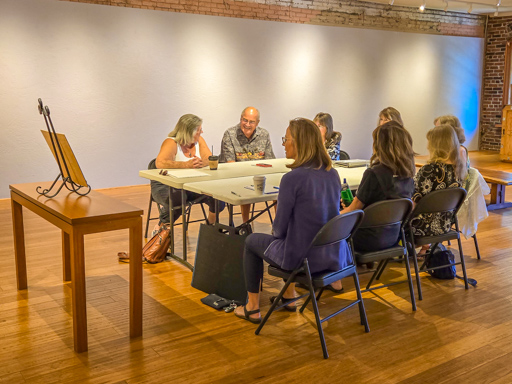Step 1: Define your needs and goals
Before searching for a group, consider what you hope to achieve. Ask yourself:
- Are you seeking technical improvement, support from the art community, or networking opportunities?
- Do you want in-person meetings, or does your schedule favor online interaction?
- Are you comfortable sharing unfinished work and receiving critiques?
- WSO supports all skill levels. A few groups are geared to advanced artists, however most are open to all skill levels. Having a sense of your goals will guide your search and help ensure you find a compatible group.
Step 2: Access WSO’s critique groups list
- Click here to see the current list of current WSO Critique Groups. This list is always available through the top menu of this website at Education > Critique Groups.
- If there’s a group in your area, or if there’s a virtual group that interests you, call the Facilitator and chat with them about observing the group. Ask questions and get feedback.

Step 3: Evaluating a critique group
Groups can differ in various ways. It is important to find a group that aligns with your temperament and objectives. When assessing a group, feel free to contact the group’s facilitator to ask questions and perhaps to visit. You may consider the following factors:
Group structure
- Most groups are informal, with time dedicated to viewing art from each attendee who desires critique. How does the group allow sufficient time for critique and make sure time is allocated equally among members?
- How many members typically attend, and what is their range of experience?
- Is the focus exclusively on watercolor, or are other media also welcome?
Culture and communication style
A healthy critique group balances encouragement with honest, actionable feedback. WSO encourages constructive, specific and respectful feedback in an atmosphere of camaraderie and support.
Can the facilitator tell you a little about how members approach and achieve these objectives?
Meeting logistics
- How often does the group meet? Weekly, biweekly, monthly?
- Where are meetings held? Online, at a community center, or in members’ homes?
- Are there membership fees or requirements, such as bringing new artwork to each session?
Step 4: Joining and participating
Once you’ve found a promising group, reach out with an introduction. Share a bit about your artistic background, your goals, and your interest in joining. Most groups appreciate enthusiasm and initiative.
- Attend your first meeting as an observer, if possible. Familiarize yourself with the group’s dynamics, rules, and expectations.
- Bring a recent piece of your work for critique. Be open to feedback and ready to take notes.
- Engage with others—ask questions, offer insights, and thank those who critique your work.
- Respect the group’s time and guidelines, including any set time limits or structures for feedback.
Step 5: Making the most of the group experience
The more you invest in your critique group, the more you will gain. Here are some tips to maximize your experience:
- Be Open: Approach feedback with a learner’s mindset. Even criticism can be a gift that helps you grow.
- Participate Actively: Share your thoughts on others’ work. Critiquing builds your analytical skills and deepens your understanding of watercolor techniques.
- Set Personal Goals: Identify aspects of your work you want to focus on, such as color harmony, composition, values or brushwork.
- Document Progress: Keep a sketchbook or journal to track your artistic growth over time.
- Foster Friendships: Connecting with group members outside meetings can strengthen the sense of community and lead to collaborations or exhibition opportunities.
Take the next step on your art journey today — start your search for the right critique group for you!
